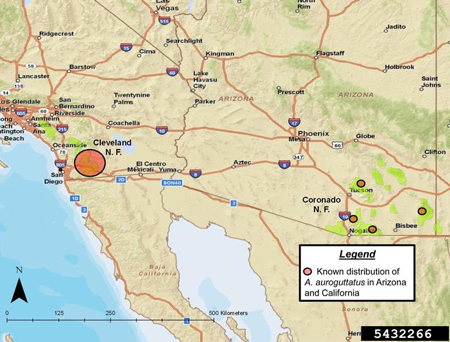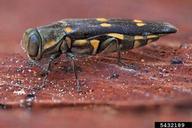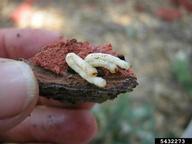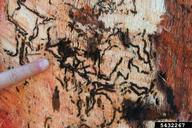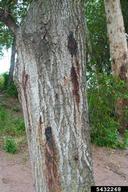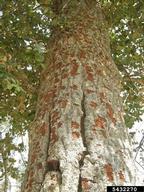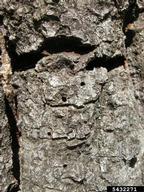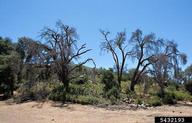Goldspotted oak borer
Agrilus auroguttatus Schaeffer (Coleoptera: Buprestidae)
Orientation to pest
Goldspotted oak borer, Agrilus auroguttatus Schaeffer, is an oak-attacking buprestid native to mountains in southern Arizona. This pest invaded southern California, likely having been moved in firewood taken by campers into public campgrounds in the region. It has killed more than 80,000 oaks in California's native oak-savannahs and is of concern as an ecological pest. It is still spreading due to unrestricted movement of firewood out of the affected parts of southern California, and the ultimate extent of potential damage is not yet known. The biology of this species is very similar to that of other Agrilus species, such as the better known emerald ash borer (Agrilus planipennis Fairmaire). In southern California, most goldspotted oak borers complete their development in one year, but some may require longer. Adults have an extended emergence period, but most do so in late June or early July. Adults have a pre-oviposition period during which they feed on oak foliage. Eggs are likely laid in crevices in the bark, and larvae after hatching bore through the bark. Young larvae feed in the outer phloem, while older larvae feed in the cambial layer. Pupation occurs in a chamber made by larvae in the outer phloem. Affected trees experience death of limbs, die back, and loss of vigor. Attacked trees often die within 2-3 years.
Hosts commonly attacked
The species most affected are coast live oak (Quercus agrifolia Née) and California black oak (Quercus kelloggii Newb.). Canyon live oak (Quercus chrysolepis Liebm.) is affected to a lesser degree. See http://en.wikipedia.org/wiki/Agrilus_coxalis
Distribution
Goldspotted oak borer occurs as a native species in southern Arizona and as an invader in southern California. A related species, now known as Agrilus coxalis Waterhouse, is native to southern Mexico and Guatemala.
| Figure 1. Known distribution of goldspotted oak borer in California (invaded range-large circle) and Arizona (native range-small circles). |
Images of goldspotted oak borer
| Figure 2. Adult goldspotted oak borer, Agrilus auroguttatus | Figure 3. Feeding larva of goldspotted oak borer, as seen in the larval gallery | Figure 4. Mature, "J"-shaped larva of goldspotted oak borer (see folded "hairpin" position of body) | Figure 5. Larval galleries of goldspotted oak borer under bark |
| Figure 6. Wet stains on bark (left) caused by feeding of larvae and scaled areas (right), where woodpeckers have removed larvae, are signs of goldspotted oak borer infestations. | Figure 7. Exit holes of goldspotted oak borer have the "D"-shape typical of buprestids | Figure 8. Dead oaks in California oak-savannah due to attack by goldspotted oak borer | |
| Figure 9. The eupelmid Calosota elongata, a larval ectoparasitoid of Agrilus auroguttatus (F, left; M, right) | |||
Important biological control agents related to this pest species
Natural enemies of this species are relatively unknown, but surveys are being conducted in the pest's native range in southern Arizona to discover species suitable for importation to California. To date, insects reared from logs infested with goldspotted oak borer have mostly been generalist predators or parasitoids use not suitable for use as classical biological control agents (for California). The euplemid Calosota elongata Gibson is a larval parasitoid, collected from Arizona, that appears to be more specialized and whose host range is under investigation. The same species has been found in California in association with goldspotted oak borer and may have been introduced along with its host. DNA studies are underway to compare the California population of C. elongata to ones in Arizona. No egg parasitoids are known.
Web links for information on goldspotted oak borer
- Goldspotted Oak Borer Research Website | University of California, Riverside
- Bibliography | Agriculture and Natural Resources, University of California
- Wikipedia Article | Wikipedia, the free encyclopedia
Article under a related but mistaken name of Agrilus coxalis
Articles
- Coleman, T. W. and S. J. Seybold. 2008. New pest in California: The goldspotted oak borer, Agrilus coxalis Waterhouse. USDA Forest Service, Pacific Southwest Region, State and Private Forestry. Pest Alert R5-RP-022. 4 pp.
- Resources Statewide Integrated Pest Management Program. 6 pp. Available online at http://www.ipm.ucdavis.edu/PDF/MISC/GSOB_field-identification-guide.pdf.
